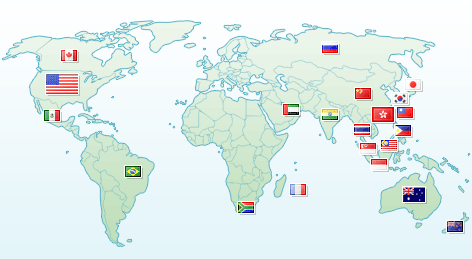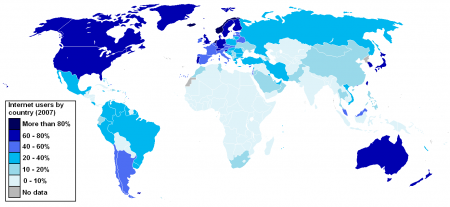2011 is officially started and I am back from my Holidays vacations as fresh as the Social Network movie on Rotten Tomatoes (97% of freshness while this post was published). Similarly to last year, I have decided to start the year with an update on the world Top 30 countries with the highest Internet penetration rate for nations with more than a million individuals. Since I like numbers and political geography, here is the new Top 30 using data from The Internet World Stats database compared to the two previous ones of respectively April 2009 (see Canada in the Worldwide Top 3 for Internet Penetration Rate) and January 2010 (see Worlwide Top 30 for Internet Penetration Rate in 2010).
| Jan. 2011 | Jan. 2010 | April 2009 | Jan. 2011 | Jan. 2010 | April 2009 | |
| Countries | Position | Position | Position | Rate | Rate | Rate |
| Norway | 1 | 1 | 2 | 94.8% | 90.9% | 87.7% |
| Sweden | 2 | 2 | 6 | 92.5% | 89.2% | 77.4% |
| Netherlands | 3 | 3 | 1 | 88.6% | 85.6% | 90.1% |
| Denmark | 4 | 4 | 14 | 86.1% | 84.2% | 68.6% |
| New Zealand | 5 | 7 | 4 | 85.4% | 79.7% | 80.5% |
| Finland | 6 | 5 | 15 | 85.3% | 83.5% | 68.6% |
| United Kingdom | 7 | 9 | 16 | 82.5% | 76.4% | 68.6% |
| South Korea | 8 | 8 | 11 | 81.1% | 77.3% | 70.7% |
| Australia | 9 | 6 | 5 | 80.1% | 80.1% | 79.4% |
| Germany | 10 | 23 | 19 | 79.1% | 65.9% | 63.8% |
| Japan | 11 | 10 | 7 | 78.2% | 75.5% | 73.8% |
| Belgium | 12 | 18 | – | 77.8% | 70.0% | – |
| Singapore | 13 | 15 | 25 | 77.8% | 72.4% | 58.6% |
| Canada | 14 | 12 | 3 | 77.7% | 74.9% | 84.3% |
| United States | 15 | 13 | 10 | 77.3% | 74.1% | 72.3% |
| United Arab Emirates | 16 | 29 | – | 75.9% | 60.9% | – |
| Switzerland | 17 | 11 | 13 | 75.3% | 75.5% | 69.0% |
| Estonia | 18 | 21 | 23 | 75.1% | 68.3% | 58.7% |
| Austria | 19 | 16 | 27 | 74.8% | 72.3% | 56.7% |
| Slovakia | 20 | 26 | – | 74.3% | 65.3% | – |
| Israel | 21 | 14 | 9 | 71.6% | 72.8% | 72.8% |
| Taiwan | 22 | 24 | 17 | 70.1% | 65.9% | 67.2% |
| France | 23 | 19 | 26 | 68.9% | 69.3% | 58.1% |
| Hong Kong | 24 | 20 | 12 | 68.8% | 69.2% | 69.5% |
| Latvia | 25 | 28 | – | 67.8% | 61.4% | – |
| Ireland | 26 | 22 | – | 65.8% | 67.3% | – |
| Czech Republic | 27 | – | – | 65.5% | – | – |
| Malaysia | 29 | 25 | 24 | 64.6% | 65.7% | 59.0% |
| Slovenia | 29 | 27 | 18 | 64.8% | 64.8% | 64.8% |
| Spain | 30 | 17 | 20 | 62.6% | 71.8% | 63.3% |
| Hungary | – | 30 | – | 61.8% | 59.3% | – |
What has changed?
As stated in my previous post last year, changes in the ranking are mainly due to two factors: (1) changes in the sources used by The Internet Worlwide Stats Database, and (2) natural growth. Since last year, not that much has changed, 9 of the countries in the Top 10 are still present and 29 of the Top 30 are still dominating this ranking. The only newcomer is Czech Republic in position 27. Scandinavia and Oceania are still leaders in terms of Internet Penetration rate while Germany and United Arab Emirates are the winners of this ranking, each gaining a whopping 13 positions. This change for Germany should be related to a change in the source which was underestimating the penetration rate. Furthermore, despite all the financial concerns raised during last recession related to the viability of all luxury hotels, villas and islands in Abu Dhabi, I would tend to think that most of the increase for the United Arab Emirates is linked to technological growth rather than a change in sources.
Furthermore, I would also add some doubts about the strange downward variation for Spain that should certainly be related to a change in source too.
Logic and statistical interpretation 101
When looking at this ranking, it is important to understand that all countries have different ways of measuring the Internet Penetration Rate, but globally unless there are bombing destroying a country similarly to Japan in World War II, there should not be more than a 2% downward variation, a variation that could be related to statistical noise. Even for growth, more than 10% for a year is generally associated to a change in the source used, especially for European countries, since absolute and relative growth is mainly seen for BRIC (Brazil, Russia, India, China) countries. Thus, even though these countries have low Internet Penetration Rates, they account for nearly one-third (32.36%) of the world Internet users population, China alone accounting for more than one-fifth (21.35%). Here is below a table representing the Internet Penetration Rate of these four countries but also the percentage of users in comparison to the world total.
| Jan. 2011 | Jan. 2011 | |
| Countries | Rate | % World |
| Brazil | 37.8% | 3.86% |
| Russia | 42.8% | 3.03% |
| India | 6.9% | 4.12% |
| China | 31.6% | 21.35% |

Conclusion
In conclusion, there is not that much new concerning the Worldwide Top 30 countries for Internet Penetration Rate. However, what will be more and more interesting to look at in the future is the growth of the BRIC countries. Furthermore, I know it’s only the beginning of the year, but if you’re looking for a techno-trendy country or city to visit, this ranking is a good complement to my post entitled The 10 Most Hi-Tech Cities in the World, but also to the lucky 13 cities in the world described in my post entitled The art of Being Perceived as an Innovative Mind in Marketing.
Happy new year to everyone!
Jean-Francois

